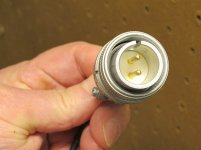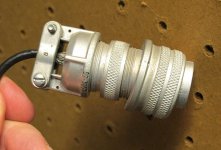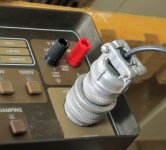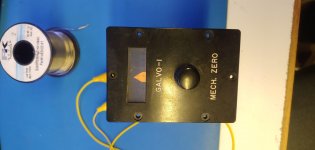I found this Keithley 140 Nanovoltmeter a few years back. Power cord was cut so I removed the battery pack and just put the meter on a shelf. Keithley was just down the road from where I drove a forklift at the die casting plant in college -- about the same era in which this instrument was built!
Just took off the cover, thought some folks would like to see the innards.
Just took off the cover, thought some folks would like to see the innards.
Attachments
-
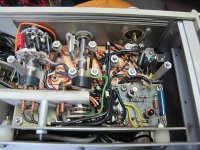 Keithley140_Input1.jpg143 KB · Views: 356
Keithley140_Input1.jpg143 KB · Views: 356 -
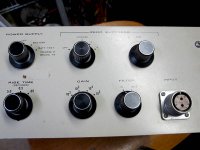 Keithley140_Front1.jpg77.4 KB · Views: 202
Keithley140_Front1.jpg77.4 KB · Views: 202 -
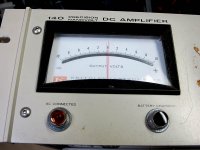 Keithley140_Front2.jpg77.2 KB · Views: 205
Keithley140_Front2.jpg77.2 KB · Views: 205 -
 Keithley140_Top.jpg125.7 KB · Views: 184
Keithley140_Top.jpg125.7 KB · Views: 184 -
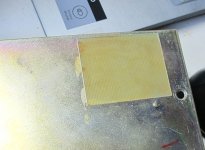 Keithley140_MoreShielding.jpg109.1 KB · Views: 152
Keithley140_MoreShielding.jpg109.1 KB · Views: 152 -
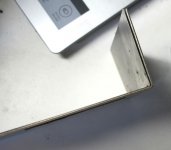 Keithley140_AmplifierShielding.jpg57 KB · Views: 346
Keithley140_AmplifierShielding.jpg57 KB · Views: 346 -
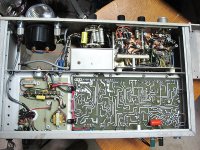 Keithley140_Bottom.jpg166.9 KB · Views: 354
Keithley140_Bottom.jpg166.9 KB · Views: 354 -
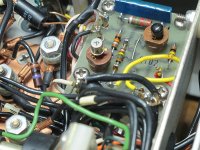 Keithley140_FirstAmplifier.jpg127.8 KB · Views: 348
Keithley140_FirstAmplifier.jpg127.8 KB · Views: 348 -
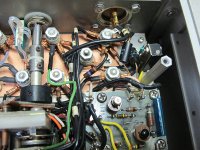 Keithley140_Input2.jpg141.4 KB · Views: 354
Keithley140_Input2.jpg141.4 KB · Views: 354
I still have my 610C electrometer but lost the special input cable. Years ago we bought their fancy electrometer with external box for the DUT that had a sapphire disk insulator. The schematic showed some proprietary MOSFET on the input with 2 back to back 1N914 diodes as protection. That was as funny as Barrie Gilbert on old Tek schematics as W(wizzard)101.
Keithley used to have a panel meter customization facility above the Pioneer Standard Electronics store in CLE -- they invited our ham radio club for a demonstration.
I purchased a Keithley 181 for a song back in the rubble of the dot-com crash. Works like a champ. The connector is the same for the 140.
I purchased a Keithley 181 for a song back in the rubble of the dot-com crash. Works like a champ. The connector is the same for the 140.
Attachments
In what year build?
Looking at the circuit board and components I would guess late 60,s /early 70,s.
The engineers at the top instrumentation companies were some of the best I ever met. I learned so much from working with the guys at Genrad, Tek, Fluke, HP/Keysight etc. Looking inside a 7 1/2 digit DVM is a wonder.
I remember one time when I was working in the medical electronics field, I was using an ESU (electro surgical unit aka RF knife), I forget who made it (>40 years ago). I looked at the schematic and I cold not begin to figure out how it worked. I later met the designer and told him that, he said "oh you'll never figure it out from the schematic, that has almost nothing to do with the way it works!".
I remember one time when I was working in the medical electronics field, I was using an ESU (electro surgical unit aka RF knife), I forget who made it (>40 years ago). I looked at the schematic and I cold not begin to figure out how it worked. I later met the designer and told him that, he said "oh you'll never figure it out from the schematic, that has almost nothing to do with the way it works!".
I have always been a fan of that company's equipment. For the "small stuff" I'm still using my Keithley 177 Microvolt DMM, and a 173A is still my daily driver.
I guess quality and accuracy never goes out of style.
I guess quality and accuracy never goes out of style.
Speaking of high sensitivity I found this in my collection of oddities. Its an optical galvanometer with a 300nA/mm sensitivity. With its 500 Ohm coil that's 150uV/division. These were used before DC amplifiers with enough sensitivity and isolation were available to look at very small voltages, usually in standards labs.
I need to figure out a use for this little number. . .
I need to figure out a use for this little number. . .
Attachments
Its an optical galvanometer with a 300nA/mm sensitivity. With its 500 Ohm coil that's 150uV/division. These were used before DC amplifiers with enough sensitivity and isolation were available to look at very small voltages, usually in standards labs.
Remember the movie "Madame Curie" (Greer Garson and Walter Pidgeon, 1943). Marie and Pierre using an optical galvonometer when they were extracting radium from pitchblende.
Speaking of high sensitivity I found this in my collection of oddities. Its an optical galvanometer with a 300nA/mm sensitivity. With its 500 Ohm coil that's 150uV/division. These were used before DC amplifiers with enough sensitivity and isolation were available to look at very small voltages, usually in standards labs.
I need to figure out a use for this little number. . .
A little known fact, Jim Williams owned Lord Kelvin's optical galvanometer.
- Home
- Design & Build
- Equipment & Tools
- Serious about nano-Volts
